Tour Operations Management Report: Industry Analysis and Strategies
VerifiedAdded on 2020/01/28
|14
|3844
|57
Report
AI Summary
This report provides a comprehensive analysis of tour operations management, focusing on the practices of Four Season Travel. It begins by examining the impact of current trends like globalization, safety concerns, service expectations, and price-value considerations on the industry. The report then details the stages and timescales involved in holiday development, including market research, location selection, and negotiation. It explores different contracting methods, such as fixed and sale-only contracts, and explains how to calculate the selling price of a holiday package. The report also delves into the planning decisions behind brochure design, comparing traditional brochures with e-brochures and assessing their suitability for different tour operators. Finally, it examines the strategic and tactical decisions made by various tour operators, providing a holistic view of the challenges and opportunities in tour operations management. The report concludes by summarizing key findings and offering insights into the future of the industry.

Paraphrase This Document
Need a fresh take? Get an instant paraphrase of this document with our AI Paraphraser
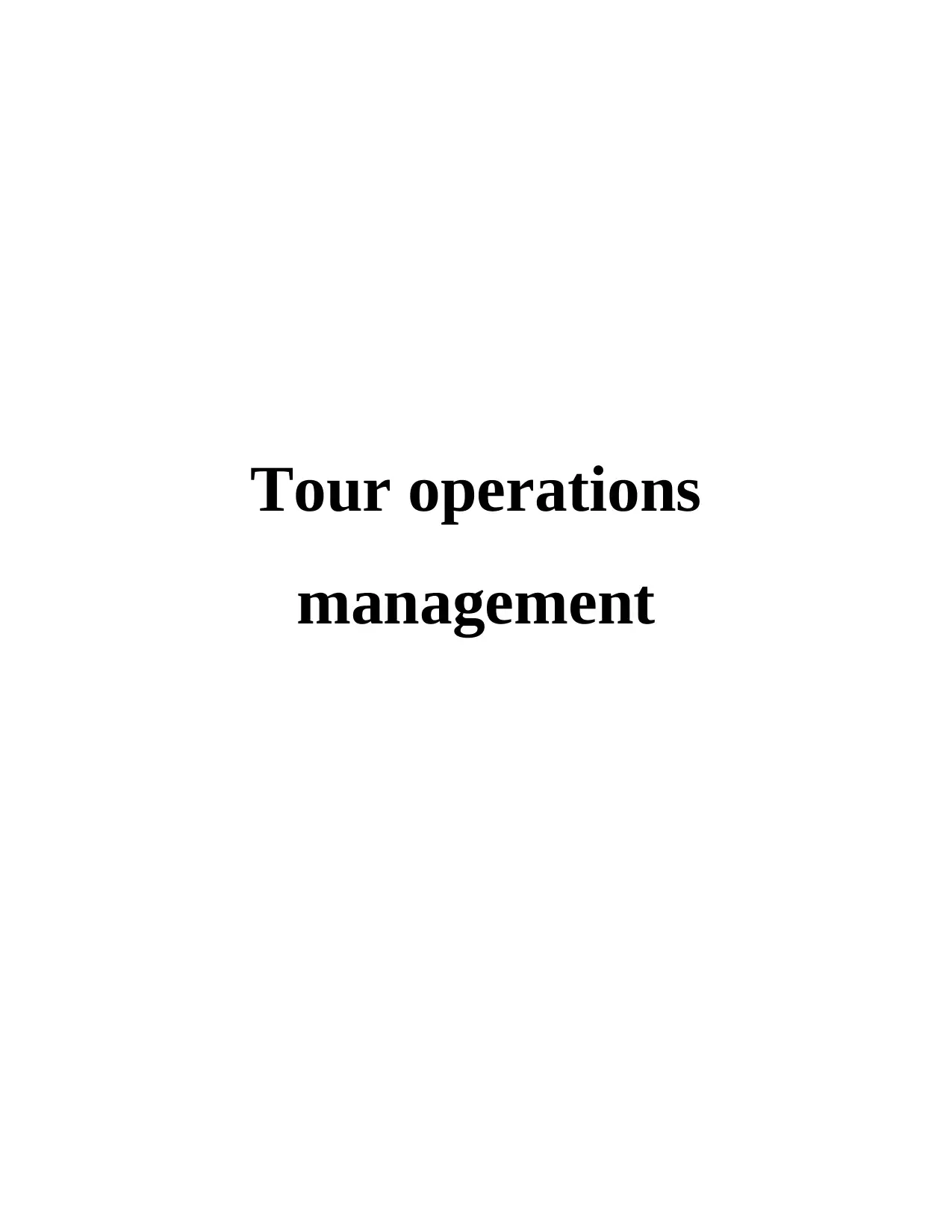
Tour operations
management
management
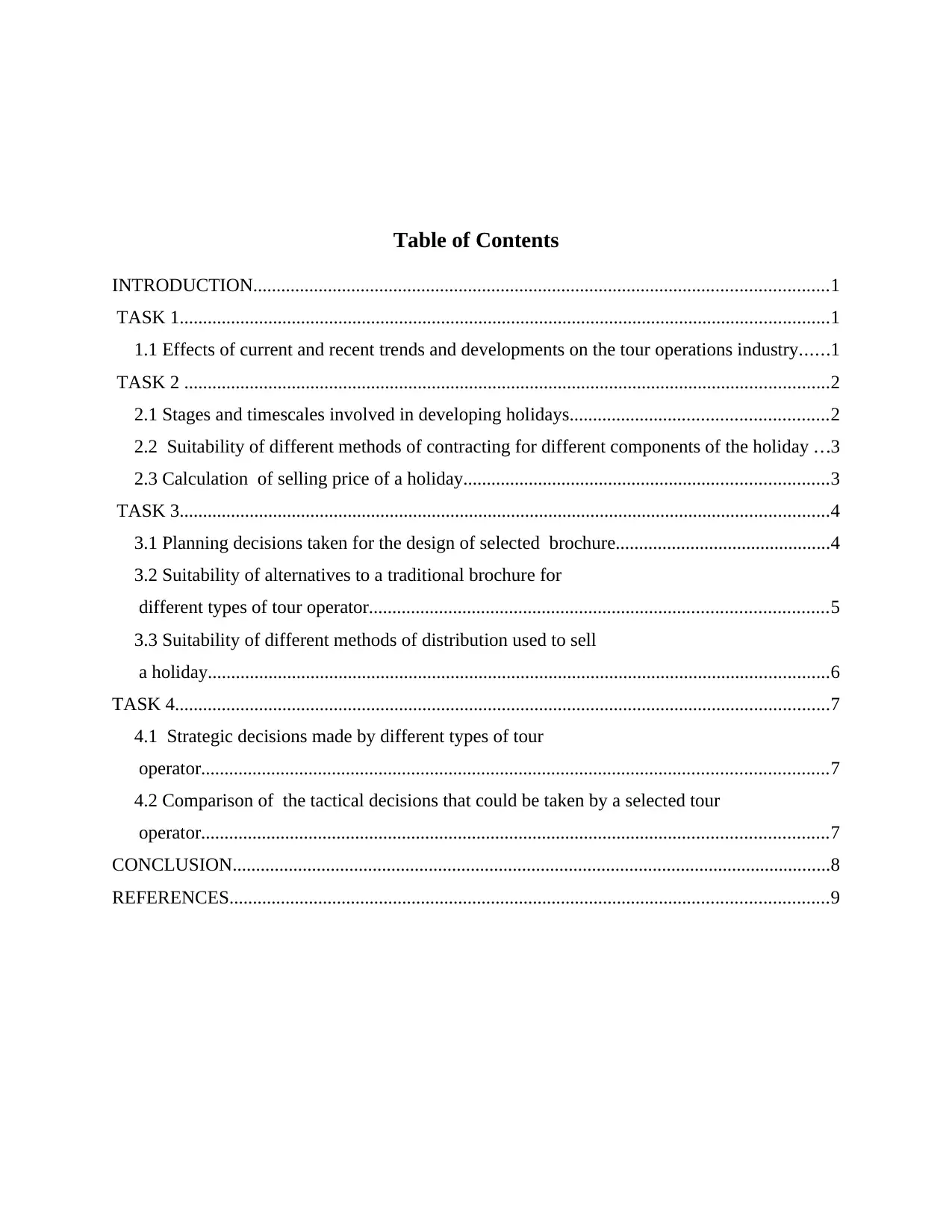
Table of Contents
INTRODUCTION...........................................................................................................................1
TASK 1...........................................................................................................................................1
1.1 Effects of current and recent trends and developments on the tour operations industry......1
TASK 2 ..........................................................................................................................................2
2.1 Stages and timescales involved in developing holidays.......................................................2
2.2 Suitability of different methods of contracting for different components of the holiday ...3
2.3 Calculation of selling price of a holiday..............................................................................3
TASK 3...........................................................................................................................................4
3.1 Planning decisions taken for the design of selected brochure..............................................4
3.2 Suitability of alternatives to a traditional brochure for
different types of tour operator..................................................................................................5
3.3 Suitability of different methods of distribution used to sell
a holiday.....................................................................................................................................6
TASK 4............................................................................................................................................7
4.1 Strategic decisions made by different types of tour
operator......................................................................................................................................7
4.2 Comparison of the tactical decisions that could be taken by a selected tour
operator......................................................................................................................................7
CONCLUSION................................................................................................................................8
REFERENCES................................................................................................................................9
INTRODUCTION...........................................................................................................................1
TASK 1...........................................................................................................................................1
1.1 Effects of current and recent trends and developments on the tour operations industry......1
TASK 2 ..........................................................................................................................................2
2.1 Stages and timescales involved in developing holidays.......................................................2
2.2 Suitability of different methods of contracting for different components of the holiday ...3
2.3 Calculation of selling price of a holiday..............................................................................3
TASK 3...........................................................................................................................................4
3.1 Planning decisions taken for the design of selected brochure..............................................4
3.2 Suitability of alternatives to a traditional brochure for
different types of tour operator..................................................................................................5
3.3 Suitability of different methods of distribution used to sell
a holiday.....................................................................................................................................6
TASK 4............................................................................................................................................7
4.1 Strategic decisions made by different types of tour
operator......................................................................................................................................7
4.2 Comparison of the tactical decisions that could be taken by a selected tour
operator......................................................................................................................................7
CONCLUSION................................................................................................................................8
REFERENCES................................................................................................................................9
⊘ This is a preview!⊘
Do you want full access?
Subscribe today to unlock all pages.

Trusted by 1+ million students worldwide

Paraphrase This Document
Need a fresh take? Get an instant paraphrase of this document with our AI Paraphraser
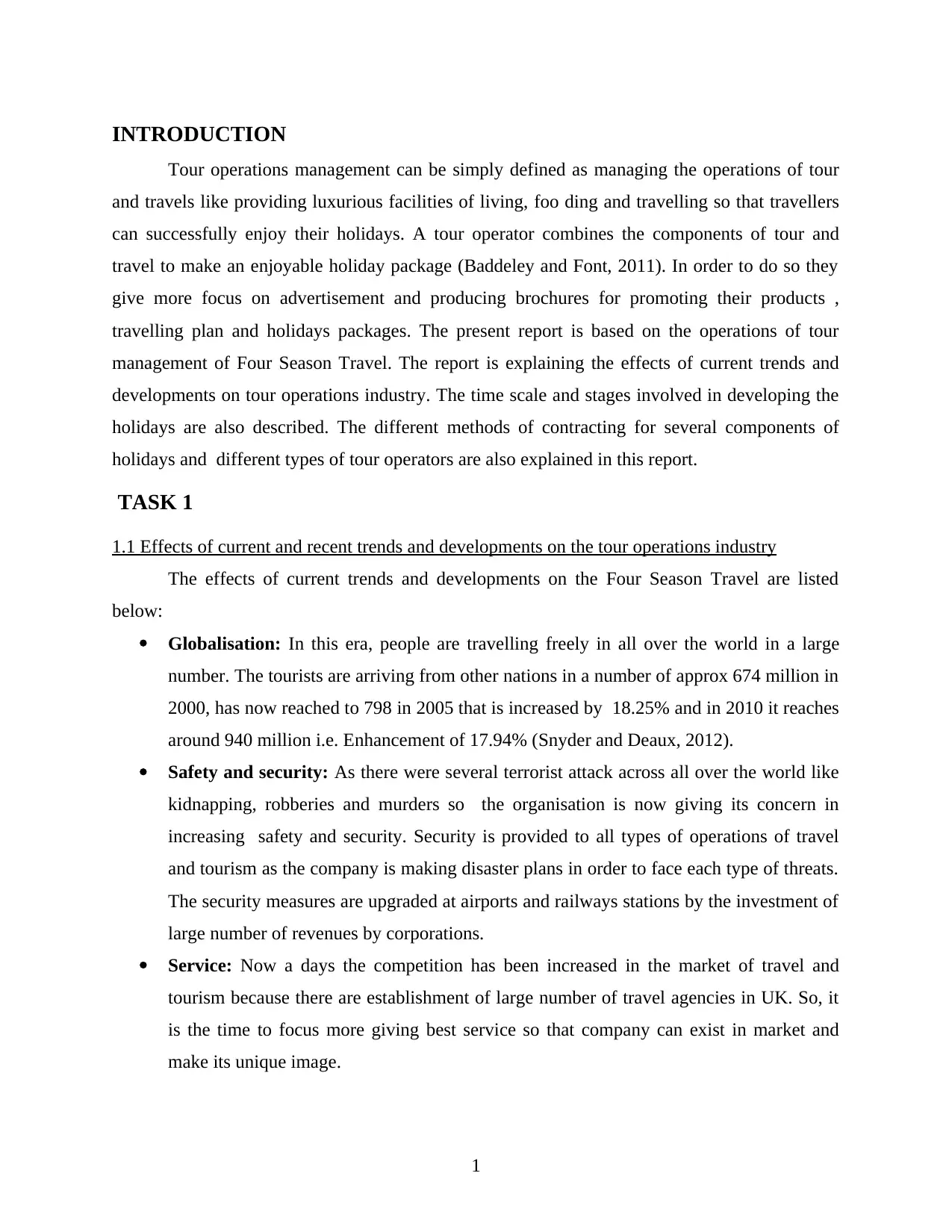
INTRODUCTION
Tour operations management can be simply defined as managing the operations of tour
and travels like providing luxurious facilities of living, foo ding and travelling so that travellers
can successfully enjoy their holidays. A tour operator combines the components of tour and
travel to make an enjoyable holiday package (Baddeley and Font, 2011). In order to do so they
give more focus on advertisement and producing brochures for promoting their products ,
travelling plan and holidays packages. The present report is based on the operations of tour
management of Four Season Travel. The report is explaining the effects of current trends and
developments on tour operations industry. The time scale and stages involved in developing the
holidays are also described. The different methods of contracting for several components of
holidays and different types of tour operators are also explained in this report.
TASK 1
1.1 Effects of current and recent trends and developments on the tour operations industry
The effects of current trends and developments on the Four Season Travel are listed
below:
Globalisation: In this era, people are travelling freely in all over the world in a large
number. The tourists are arriving from other nations in a number of approx 674 million in
2000, has now reached to 798 in 2005 that is increased by 18.25% and in 2010 it reaches
around 940 million i.e. Enhancement of 17.94% (Snyder and Deaux, 2012).
Safety and security: As there were several terrorist attack across all over the world like
kidnapping, robberies and murders so the organisation is now giving its concern in
increasing safety and security. Security is provided to all types of operations of travel
and tourism as the company is making disaster plans in order to face each type of threats.
The security measures are upgraded at airports and railways stations by the investment of
large number of revenues by corporations.
Service: Now a days the competition has been increased in the market of travel and
tourism because there are establishment of large number of travel agencies in UK. So, it
is the time to focus more giving best service so that company can exist in market and
make its unique image.
1
Tour operations management can be simply defined as managing the operations of tour
and travels like providing luxurious facilities of living, foo ding and travelling so that travellers
can successfully enjoy their holidays. A tour operator combines the components of tour and
travel to make an enjoyable holiday package (Baddeley and Font, 2011). In order to do so they
give more focus on advertisement and producing brochures for promoting their products ,
travelling plan and holidays packages. The present report is based on the operations of tour
management of Four Season Travel. The report is explaining the effects of current trends and
developments on tour operations industry. The time scale and stages involved in developing the
holidays are also described. The different methods of contracting for several components of
holidays and different types of tour operators are also explained in this report.
TASK 1
1.1 Effects of current and recent trends and developments on the tour operations industry
The effects of current trends and developments on the Four Season Travel are listed
below:
Globalisation: In this era, people are travelling freely in all over the world in a large
number. The tourists are arriving from other nations in a number of approx 674 million in
2000, has now reached to 798 in 2005 that is increased by 18.25% and in 2010 it reaches
around 940 million i.e. Enhancement of 17.94% (Snyder and Deaux, 2012).
Safety and security: As there were several terrorist attack across all over the world like
kidnapping, robberies and murders so the organisation is now giving its concern in
increasing safety and security. Security is provided to all types of operations of travel
and tourism as the company is making disaster plans in order to face each type of threats.
The security measures are upgraded at airports and railways stations by the investment of
large number of revenues by corporations.
Service: Now a days the competition has been increased in the market of travel and
tourism because there are establishment of large number of travel agencies in UK. So, it
is the time to focus more giving best service so that company can exist in market and
make its unique image.
1
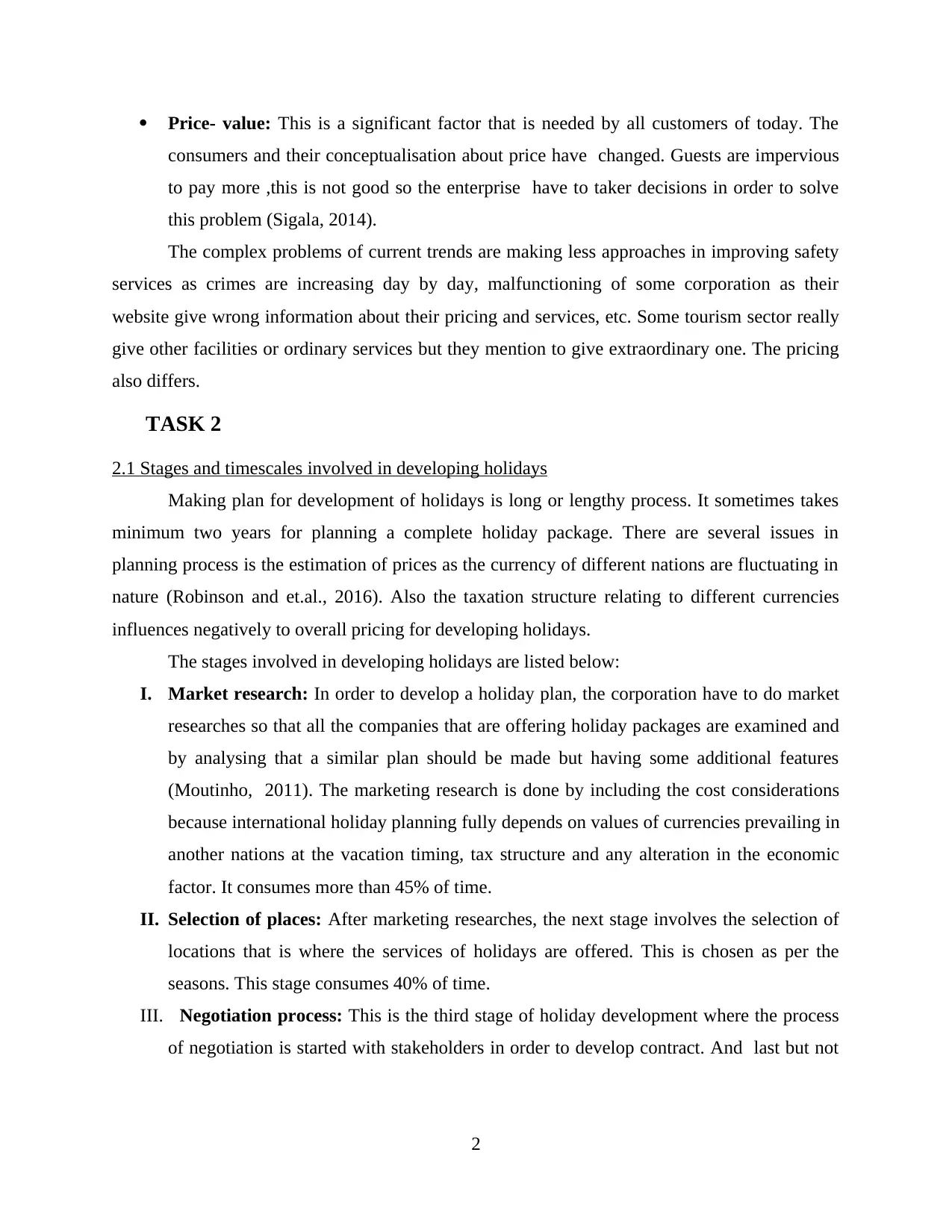
Price- value: This is a significant factor that is needed by all customers of today. The
consumers and their conceptualisation about price have changed. Guests are impervious
to pay more ,this is not good so the enterprise have to taker decisions in order to solve
this problem (Sigala, 2014).
The complex problems of current trends are making less approaches in improving safety
services as crimes are increasing day by day, malfunctioning of some corporation as their
website give wrong information about their pricing and services, etc. Some tourism sector really
give other facilities or ordinary services but they mention to give extraordinary one. The pricing
also differs.
TASK 2
2.1 Stages and timescales involved in developing holidays
Making plan for development of holidays is long or lengthy process. It sometimes takes
minimum two years for planning a complete holiday package. There are several issues in
planning process is the estimation of prices as the currency of different nations are fluctuating in
nature (Robinson and et.al., 2016). Also the taxation structure relating to different currencies
influences negatively to overall pricing for developing holidays.
The stages involved in developing holidays are listed below:
I. Market research: In order to develop a holiday plan, the corporation have to do market
researches so that all the companies that are offering holiday packages are examined and
by analysing that a similar plan should be made but having some additional features
(Moutinho, 2011). The marketing research is done by including the cost considerations
because international holiday planning fully depends on values of currencies prevailing in
another nations at the vacation timing, tax structure and any alteration in the economic
factor. It consumes more than 45% of time.
II. Selection of places: After marketing researches, the next stage involves the selection of
locations that is where the services of holidays are offered. This is chosen as per the
seasons. This stage consumes 40% of time.
III. Negotiation process: This is the third stage of holiday development where the process
of negotiation is started with stakeholders in order to develop contract. And last but not
2
consumers and their conceptualisation about price have changed. Guests are impervious
to pay more ,this is not good so the enterprise have to taker decisions in order to solve
this problem (Sigala, 2014).
The complex problems of current trends are making less approaches in improving safety
services as crimes are increasing day by day, malfunctioning of some corporation as their
website give wrong information about their pricing and services, etc. Some tourism sector really
give other facilities or ordinary services but they mention to give extraordinary one. The pricing
also differs.
TASK 2
2.1 Stages and timescales involved in developing holidays
Making plan for development of holidays is long or lengthy process. It sometimes takes
minimum two years for planning a complete holiday package. There are several issues in
planning process is the estimation of prices as the currency of different nations are fluctuating in
nature (Robinson and et.al., 2016). Also the taxation structure relating to different currencies
influences negatively to overall pricing for developing holidays.
The stages involved in developing holidays are listed below:
I. Market research: In order to develop a holiday plan, the corporation have to do market
researches so that all the companies that are offering holiday packages are examined and
by analysing that a similar plan should be made but having some additional features
(Moutinho, 2011). The marketing research is done by including the cost considerations
because international holiday planning fully depends on values of currencies prevailing in
another nations at the vacation timing, tax structure and any alteration in the economic
factor. It consumes more than 45% of time.
II. Selection of places: After marketing researches, the next stage involves the selection of
locations that is where the services of holidays are offered. This is chosen as per the
seasons. This stage consumes 40% of time.
III. Negotiation process: This is the third stage of holiday development where the process
of negotiation is started with stakeholders in order to develop contract. And last but not
2
⊘ This is a preview!⊘
Do you want full access?
Subscribe today to unlock all pages.

Trusted by 1+ million students worldwide
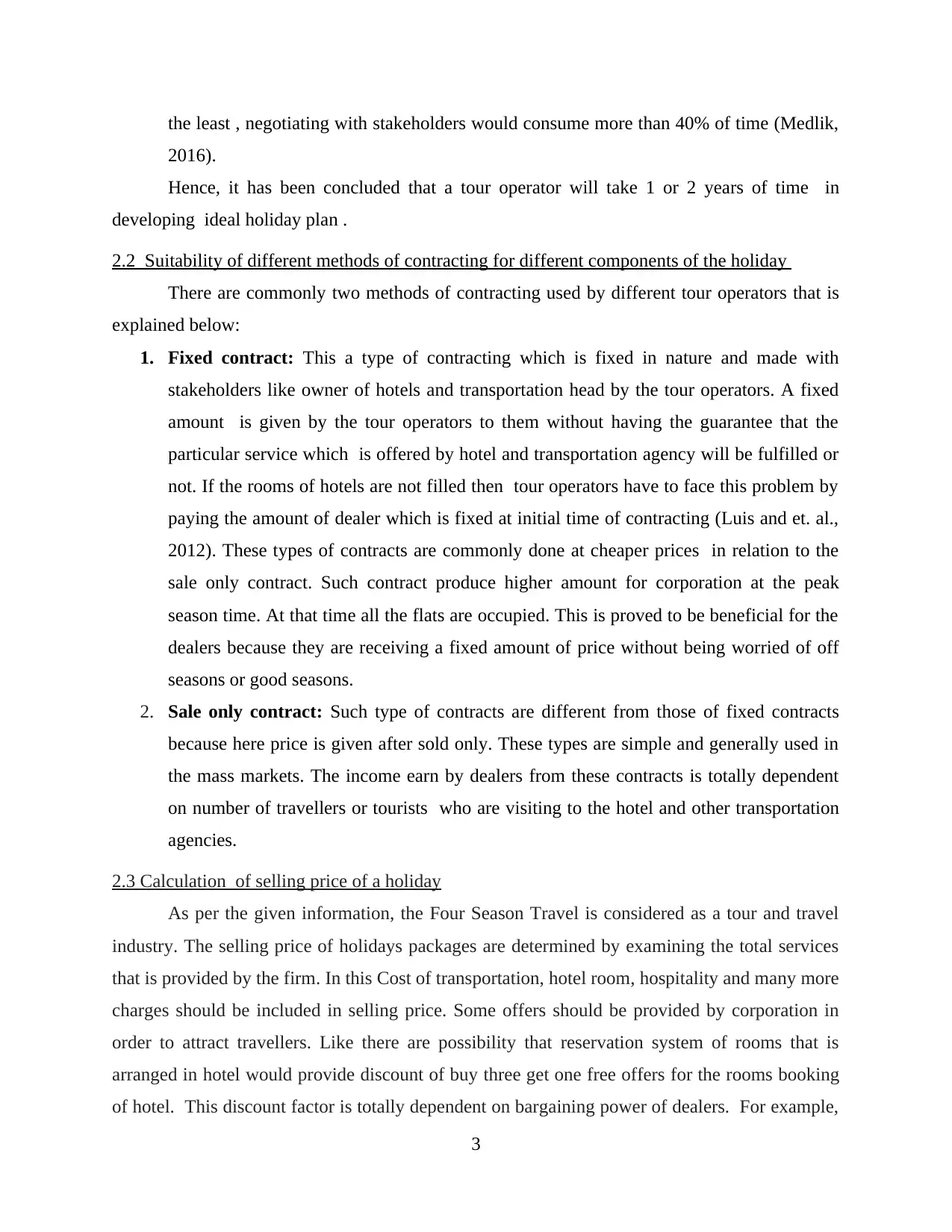
the least , negotiating with stakeholders would consume more than 40% of time (Medlik,
2016).
Hence, it has been concluded that a tour operator will take 1 or 2 years of time in
developing ideal holiday plan .
2.2 Suitability of different methods of contracting for different components of the holiday
There are commonly two methods of contracting used by different tour operators that is
explained below:
1. Fixed contract: This a type of contracting which is fixed in nature and made with
stakeholders like owner of hotels and transportation head by the tour operators. A fixed
amount is given by the tour operators to them without having the guarantee that the
particular service which is offered by hotel and transportation agency will be fulfilled or
not. If the rooms of hotels are not filled then tour operators have to face this problem by
paying the amount of dealer which is fixed at initial time of contracting (Luis and et. al.,
2012). These types of contracts are commonly done at cheaper prices in relation to the
sale only contract. Such contract produce higher amount for corporation at the peak
season time. At that time all the flats are occupied. This is proved to be beneficial for the
dealers because they are receiving a fixed amount of price without being worried of off
seasons or good seasons.
2. Sale only contract: Such type of contracts are different from those of fixed contracts
because here price is given after sold only. These types are simple and generally used in
the mass markets. The income earn by dealers from these contracts is totally dependent
on number of travellers or tourists who are visiting to the hotel and other transportation
agencies.
2.3 Calculation of selling price of a holiday
As per the given information, the Four Season Travel is considered as a tour and travel
industry. The selling price of holidays packages are determined by examining the total services
that is provided by the firm. In this Cost of transportation, hotel room, hospitality and many more
charges should be included in selling price. Some offers should be provided by corporation in
order to attract travellers. Like there are possibility that reservation system of rooms that is
arranged in hotel would provide discount of buy three get one free offers for the rooms booking
of hotel. This discount factor is totally dependent on bargaining power of dealers. For example,
3
2016).
Hence, it has been concluded that a tour operator will take 1 or 2 years of time in
developing ideal holiday plan .
2.2 Suitability of different methods of contracting for different components of the holiday
There are commonly two methods of contracting used by different tour operators that is
explained below:
1. Fixed contract: This a type of contracting which is fixed in nature and made with
stakeholders like owner of hotels and transportation head by the tour operators. A fixed
amount is given by the tour operators to them without having the guarantee that the
particular service which is offered by hotel and transportation agency will be fulfilled or
not. If the rooms of hotels are not filled then tour operators have to face this problem by
paying the amount of dealer which is fixed at initial time of contracting (Luis and et. al.,
2012). These types of contracts are commonly done at cheaper prices in relation to the
sale only contract. Such contract produce higher amount for corporation at the peak
season time. At that time all the flats are occupied. This is proved to be beneficial for the
dealers because they are receiving a fixed amount of price without being worried of off
seasons or good seasons.
2. Sale only contract: Such type of contracts are different from those of fixed contracts
because here price is given after sold only. These types are simple and generally used in
the mass markets. The income earn by dealers from these contracts is totally dependent
on number of travellers or tourists who are visiting to the hotel and other transportation
agencies.
2.3 Calculation of selling price of a holiday
As per the given information, the Four Season Travel is considered as a tour and travel
industry. The selling price of holidays packages are determined by examining the total services
that is provided by the firm. In this Cost of transportation, hotel room, hospitality and many more
charges should be included in selling price. Some offers should be provided by corporation in
order to attract travellers. Like there are possibility that reservation system of rooms that is
arranged in hotel would provide discount of buy three get one free offers for the rooms booking
of hotel. This discount factor is totally dependent on bargaining power of dealers. For example,
3
Paraphrase This Document
Need a fresh take? Get an instant paraphrase of this document with our AI Paraphraser
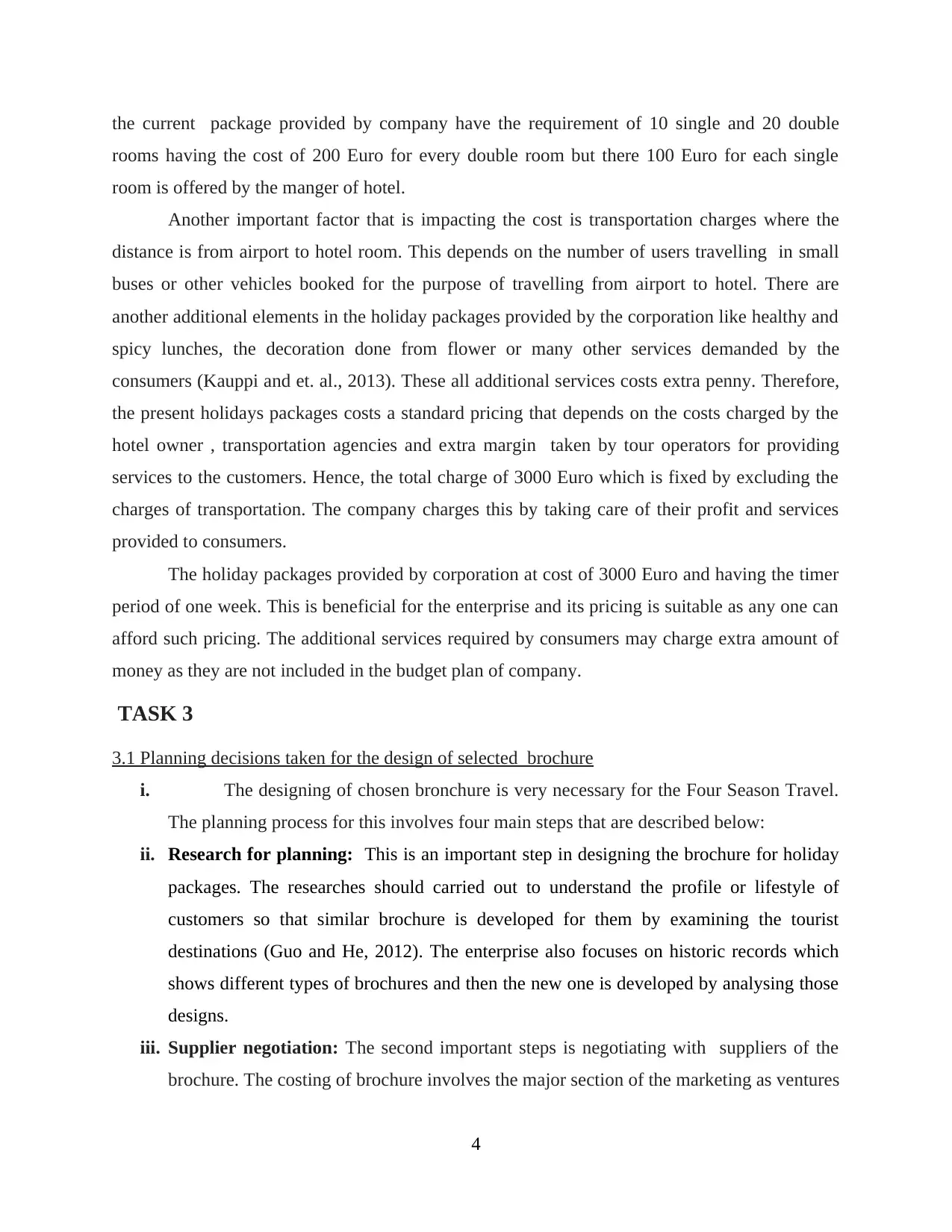
the current package provided by company have the requirement of 10 single and 20 double
rooms having the cost of 200 Euro for every double room but there 100 Euro for each single
room is offered by the manger of hotel.
Another important factor that is impacting the cost is transportation charges where the
distance is from airport to hotel room. This depends on the number of users travelling in small
buses or other vehicles booked for the purpose of travelling from airport to hotel. There are
another additional elements in the holiday packages provided by the corporation like healthy and
spicy lunches, the decoration done from flower or many other services demanded by the
consumers (Kauppi and et. al., 2013). These all additional services costs extra penny. Therefore,
the present holidays packages costs a standard pricing that depends on the costs charged by the
hotel owner , transportation agencies and extra margin taken by tour operators for providing
services to the customers. Hence, the total charge of 3000 Euro which is fixed by excluding the
charges of transportation. The company charges this by taking care of their profit and services
provided to consumers.
The holiday packages provided by corporation at cost of 3000 Euro and having the timer
period of one week. This is beneficial for the enterprise and its pricing is suitable as any one can
afford such pricing. The additional services required by consumers may charge extra amount of
money as they are not included in the budget plan of company.
TASK 3
3.1 Planning decisions taken for the design of selected brochure
i. The designing of chosen bronchure is very necessary for the Four Season Travel.
The planning process for this involves four main steps that are described below:
ii. Research for planning: This is an important step in designing the brochure for holiday
packages. The researches should carried out to understand the profile or lifestyle of
customers so that similar brochure is developed for them by examining the tourist
destinations (Guo and He, 2012). The enterprise also focuses on historic records which
shows different types of brochures and then the new one is developed by analysing those
designs.
iii. Supplier negotiation: The second important steps is negotiating with suppliers of the
brochure. The costing of brochure involves the major section of the marketing as ventures
4
rooms having the cost of 200 Euro for every double room but there 100 Euro for each single
room is offered by the manger of hotel.
Another important factor that is impacting the cost is transportation charges where the
distance is from airport to hotel room. This depends on the number of users travelling in small
buses or other vehicles booked for the purpose of travelling from airport to hotel. There are
another additional elements in the holiday packages provided by the corporation like healthy and
spicy lunches, the decoration done from flower or many other services demanded by the
consumers (Kauppi and et. al., 2013). These all additional services costs extra penny. Therefore,
the present holidays packages costs a standard pricing that depends on the costs charged by the
hotel owner , transportation agencies and extra margin taken by tour operators for providing
services to the customers. Hence, the total charge of 3000 Euro which is fixed by excluding the
charges of transportation. The company charges this by taking care of their profit and services
provided to consumers.
The holiday packages provided by corporation at cost of 3000 Euro and having the timer
period of one week. This is beneficial for the enterprise and its pricing is suitable as any one can
afford such pricing. The additional services required by consumers may charge extra amount of
money as they are not included in the budget plan of company.
TASK 3
3.1 Planning decisions taken for the design of selected brochure
i. The designing of chosen bronchure is very necessary for the Four Season Travel.
The planning process for this involves four main steps that are described below:
ii. Research for planning: This is an important step in designing the brochure for holiday
packages. The researches should carried out to understand the profile or lifestyle of
customers so that similar brochure is developed for them by examining the tourist
destinations (Guo and He, 2012). The enterprise also focuses on historic records which
shows different types of brochures and then the new one is developed by analysing those
designs.
iii. Supplier negotiation: The second important steps is negotiating with suppliers of the
brochure. The costing of brochure involves the major section of the marketing as ventures
4
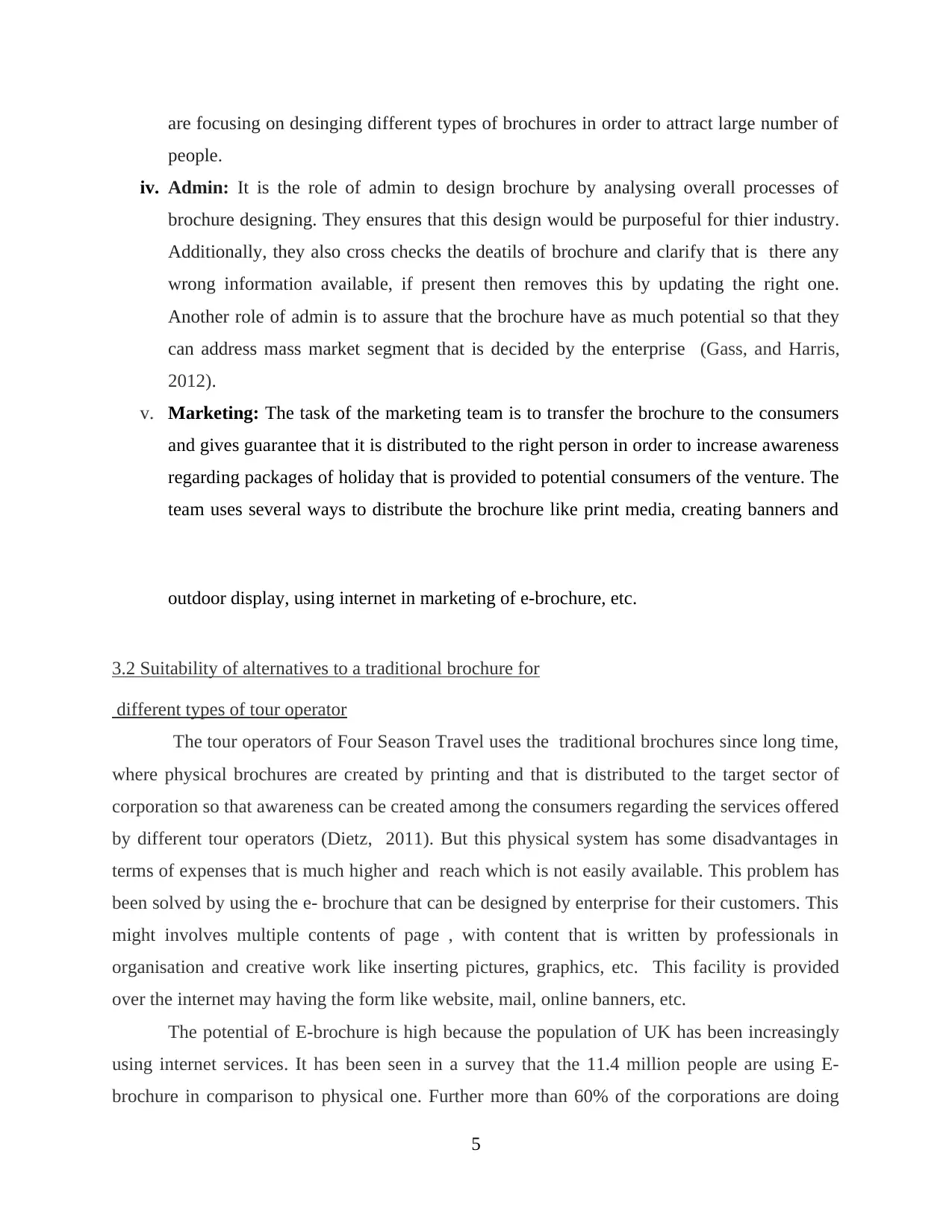
are focusing on desinging different types of brochures in order to attract large number of
people.
iv. Admin: It is the role of admin to design brochure by analysing overall processes of
brochure designing. They ensures that this design would be purposeful for thier industry.
Additionally, they also cross checks the deatils of brochure and clarify that is there any
wrong information available, if present then removes this by updating the right one.
Another role of admin is to assure that the brochure have as much potential so that they
can address mass market segment that is decided by the enterprise (Gass, and Harris,
2012).
v. Marketing: The task of the marketing team is to transfer the brochure to the consumers
and gives guarantee that it is distributed to the right person in order to increase awareness
regarding packages of holiday that is provided to potential consumers of the venture. The
team uses several ways to distribute the brochure like print media, creating banners and
outdoor display, using internet in marketing of e-brochure, etc.
3.2 Suitability of alternatives to a traditional brochure for
different types of tour operator
The tour operators of Four Season Travel uses the traditional brochures since long time,
where physical brochures are created by printing and that is distributed to the target sector of
corporation so that awareness can be created among the consumers regarding the services offered
by different tour operators (Dietz, 2011). But this physical system has some disadvantages in
terms of expenses that is much higher and reach which is not easily available. This problem has
been solved by using the e- brochure that can be designed by enterprise for their customers. This
might involves multiple contents of page , with content that is written by professionals in
organisation and creative work like inserting pictures, graphics, etc. This facility is provided
over the internet may having the form like website, mail, online banners, etc.
The potential of E-brochure is high because the population of UK has been increasingly
using internet services. It has been seen in a survey that the 11.4 million people are using E-
brochure in comparison to physical one. Further more than 60% of the corporations are doing
5
people.
iv. Admin: It is the role of admin to design brochure by analysing overall processes of
brochure designing. They ensures that this design would be purposeful for thier industry.
Additionally, they also cross checks the deatils of brochure and clarify that is there any
wrong information available, if present then removes this by updating the right one.
Another role of admin is to assure that the brochure have as much potential so that they
can address mass market segment that is decided by the enterprise (Gass, and Harris,
2012).
v. Marketing: The task of the marketing team is to transfer the brochure to the consumers
and gives guarantee that it is distributed to the right person in order to increase awareness
regarding packages of holiday that is provided to potential consumers of the venture. The
team uses several ways to distribute the brochure like print media, creating banners and
outdoor display, using internet in marketing of e-brochure, etc.
3.2 Suitability of alternatives to a traditional brochure for
different types of tour operator
The tour operators of Four Season Travel uses the traditional brochures since long time,
where physical brochures are created by printing and that is distributed to the target sector of
corporation so that awareness can be created among the consumers regarding the services offered
by different tour operators (Dietz, 2011). But this physical system has some disadvantages in
terms of expenses that is much higher and reach which is not easily available. This problem has
been solved by using the e- brochure that can be designed by enterprise for their customers. This
might involves multiple contents of page , with content that is written by professionals in
organisation and creative work like inserting pictures, graphics, etc. This facility is provided
over the internet may having the form like website, mail, online banners, etc.
The potential of E-brochure is high because the population of UK has been increasingly
using internet services. It has been seen in a survey that the 11.4 million people are using E-
brochure in comparison to physical one. Further more than 60% of the corporations are doing
5
⊘ This is a preview!⊘
Do you want full access?
Subscribe today to unlock all pages.

Trusted by 1+ million students worldwide
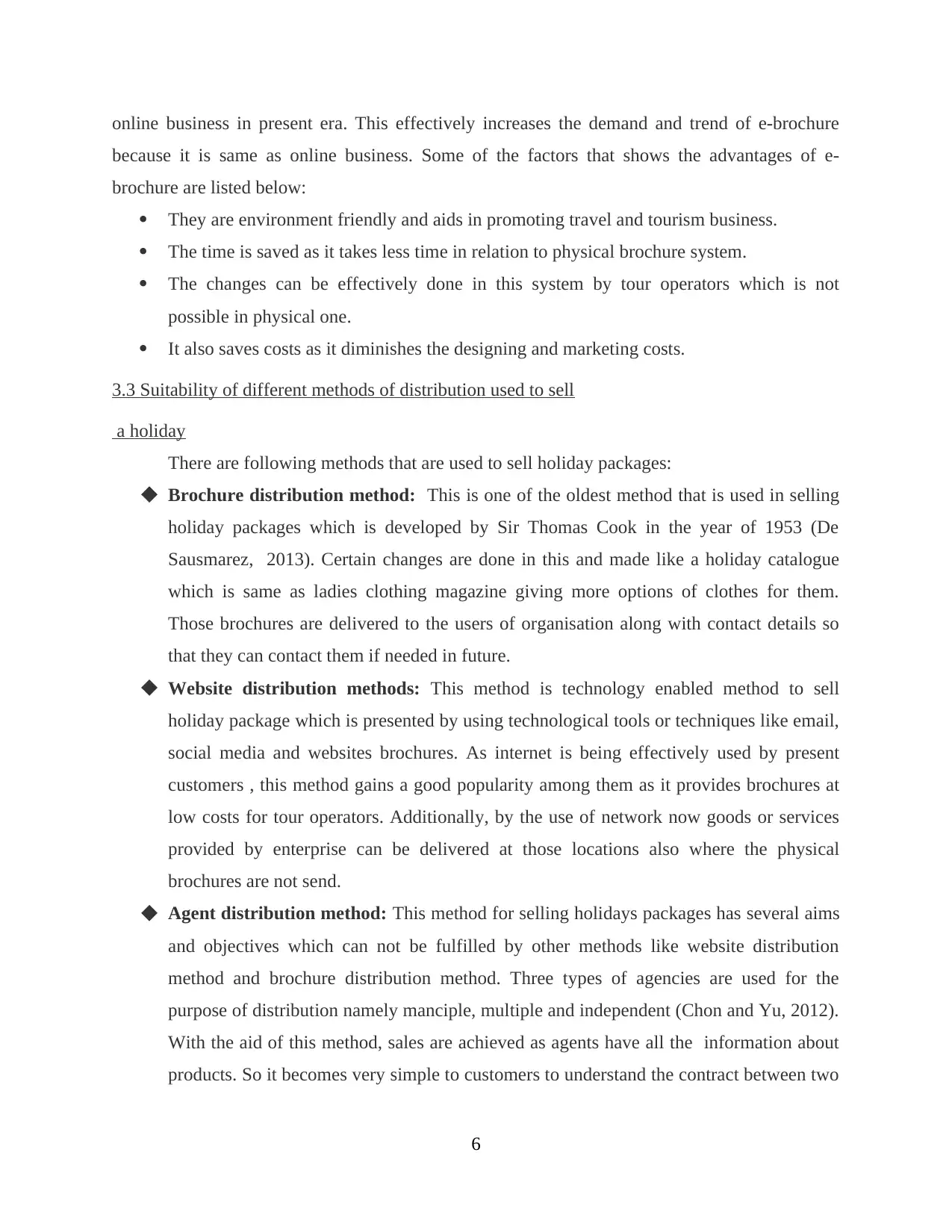
online business in present era. This effectively increases the demand and trend of e-brochure
because it is same as online business. Some of the factors that shows the advantages of e-
brochure are listed below:
They are environment friendly and aids in promoting travel and tourism business.
The time is saved as it takes less time in relation to physical brochure system.
The changes can be effectively done in this system by tour operators which is not
possible in physical one.
It also saves costs as it diminishes the designing and marketing costs.
3.3 Suitability of different methods of distribution used to sell
a holiday
There are following methods that are used to sell holiday packages:
Brochure distribution method: This is one of the oldest method that is used in selling
holiday packages which is developed by Sir Thomas Cook in the year of 1953 (De
Sausmarez, 2013). Certain changes are done in this and made like a holiday catalogue
which is same as ladies clothing magazine giving more options of clothes for them.
Those brochures are delivered to the users of organisation along with contact details so
that they can contact them if needed in future.
Website distribution methods: This method is technology enabled method to sell
holiday package which is presented by using technological tools or techniques like email,
social media and websites brochures. As internet is being effectively used by present
customers , this method gains a good popularity among them as it provides brochures at
low costs for tour operators. Additionally, by the use of network now goods or services
provided by enterprise can be delivered at those locations also where the physical
brochures are not send.
Agent distribution method: This method for selling holidays packages has several aims
and objectives which can not be fulfilled by other methods like website distribution
method and brochure distribution method. Three types of agencies are used for the
purpose of distribution namely manciple, multiple and independent (Chon and Yu, 2012).
With the aid of this method, sales are achieved as agents have all the information about
products. So it becomes very simple to customers to understand the contract between two
6
because it is same as online business. Some of the factors that shows the advantages of e-
brochure are listed below:
They are environment friendly and aids in promoting travel and tourism business.
The time is saved as it takes less time in relation to physical brochure system.
The changes can be effectively done in this system by tour operators which is not
possible in physical one.
It also saves costs as it diminishes the designing and marketing costs.
3.3 Suitability of different methods of distribution used to sell
a holiday
There are following methods that are used to sell holiday packages:
Brochure distribution method: This is one of the oldest method that is used in selling
holiday packages which is developed by Sir Thomas Cook in the year of 1953 (De
Sausmarez, 2013). Certain changes are done in this and made like a holiday catalogue
which is same as ladies clothing magazine giving more options of clothes for them.
Those brochures are delivered to the users of organisation along with contact details so
that they can contact them if needed in future.
Website distribution methods: This method is technology enabled method to sell
holiday package which is presented by using technological tools or techniques like email,
social media and websites brochures. As internet is being effectively used by present
customers , this method gains a good popularity among them as it provides brochures at
low costs for tour operators. Additionally, by the use of network now goods or services
provided by enterprise can be delivered at those locations also where the physical
brochures are not send.
Agent distribution method: This method for selling holidays packages has several aims
and objectives which can not be fulfilled by other methods like website distribution
method and brochure distribution method. Three types of agencies are used for the
purpose of distribution namely manciple, multiple and independent (Chon and Yu, 2012).
With the aid of this method, sales are achieved as agents have all the information about
products. So it becomes very simple to customers to understand the contract between two
6
Paraphrase This Document
Need a fresh take? Get an instant paraphrase of this document with our AI Paraphraser
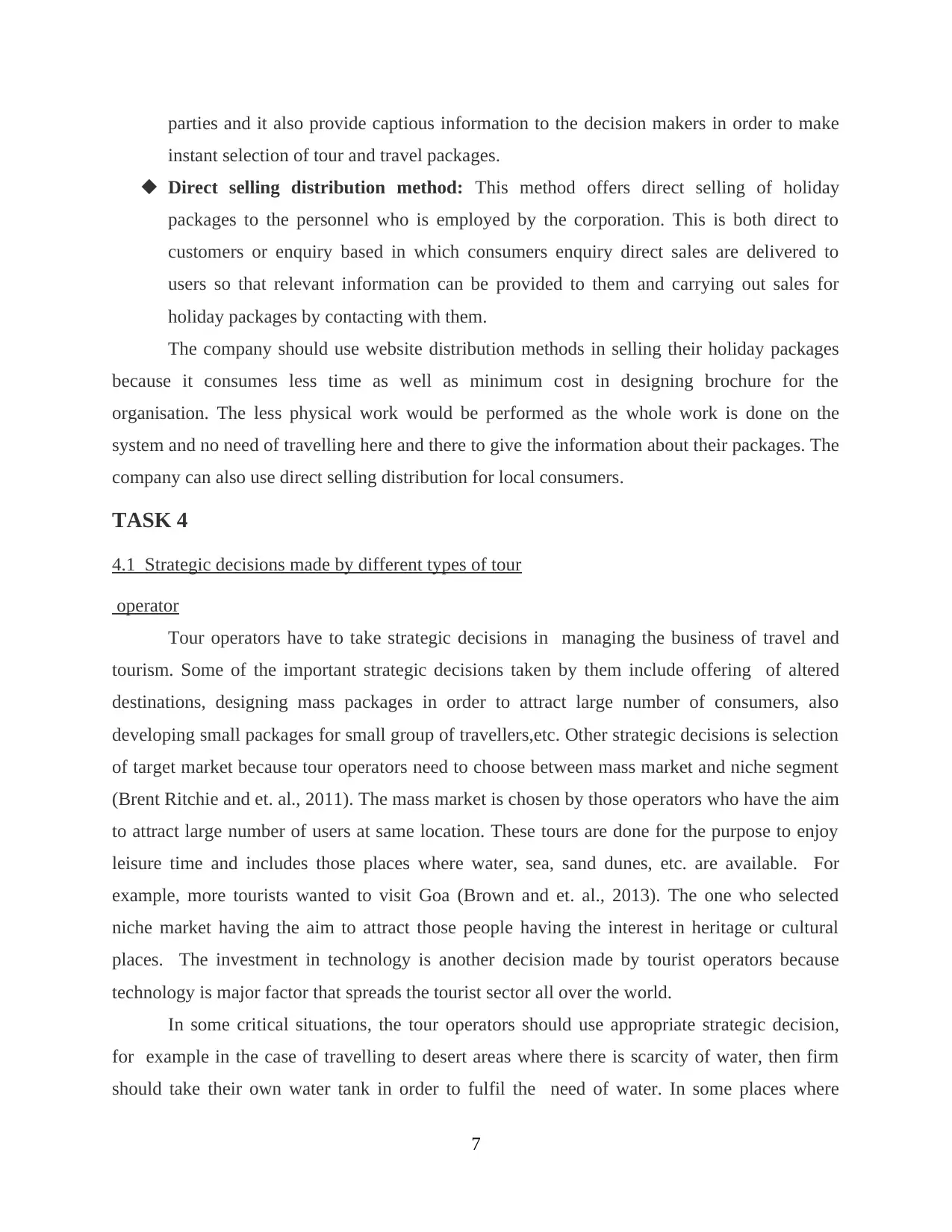
parties and it also provide captious information to the decision makers in order to make
instant selection of tour and travel packages.
Direct selling distribution method: This method offers direct selling of holiday
packages to the personnel who is employed by the corporation. This is both direct to
customers or enquiry based in which consumers enquiry direct sales are delivered to
users so that relevant information can be provided to them and carrying out sales for
holiday packages by contacting with them.
The company should use website distribution methods in selling their holiday packages
because it consumes less time as well as minimum cost in designing brochure for the
organisation. The less physical work would be performed as the whole work is done on the
system and no need of travelling here and there to give the information about their packages. The
company can also use direct selling distribution for local consumers.
TASK 4
4.1 Strategic decisions made by different types of tour
operator
Tour operators have to take strategic decisions in managing the business of travel and
tourism. Some of the important strategic decisions taken by them include offering of altered
destinations, designing mass packages in order to attract large number of consumers, also
developing small packages for small group of travellers,etc. Other strategic decisions is selection
of target market because tour operators need to choose between mass market and niche segment
(Brent Ritchie and et. al., 2011). The mass market is chosen by those operators who have the aim
to attract large number of users at same location. These tours are done for the purpose to enjoy
leisure time and includes those places where water, sea, sand dunes, etc. are available. For
example, more tourists wanted to visit Goa (Brown and et. al., 2013). The one who selected
niche market having the aim to attract those people having the interest in heritage or cultural
places. The investment in technology is another decision made by tourist operators because
technology is major factor that spreads the tourist sector all over the world.
In some critical situations, the tour operators should use appropriate strategic decision,
for example in the case of travelling to desert areas where there is scarcity of water, then firm
should take their own water tank in order to fulfil the need of water. In some places where
7
instant selection of tour and travel packages.
Direct selling distribution method: This method offers direct selling of holiday
packages to the personnel who is employed by the corporation. This is both direct to
customers or enquiry based in which consumers enquiry direct sales are delivered to
users so that relevant information can be provided to them and carrying out sales for
holiday packages by contacting with them.
The company should use website distribution methods in selling their holiday packages
because it consumes less time as well as minimum cost in designing brochure for the
organisation. The less physical work would be performed as the whole work is done on the
system and no need of travelling here and there to give the information about their packages. The
company can also use direct selling distribution for local consumers.
TASK 4
4.1 Strategic decisions made by different types of tour
operator
Tour operators have to take strategic decisions in managing the business of travel and
tourism. Some of the important strategic decisions taken by them include offering of altered
destinations, designing mass packages in order to attract large number of consumers, also
developing small packages for small group of travellers,etc. Other strategic decisions is selection
of target market because tour operators need to choose between mass market and niche segment
(Brent Ritchie and et. al., 2011). The mass market is chosen by those operators who have the aim
to attract large number of users at same location. These tours are done for the purpose to enjoy
leisure time and includes those places where water, sea, sand dunes, etc. are available. For
example, more tourists wanted to visit Goa (Brown and et. al., 2013). The one who selected
niche market having the aim to attract those people having the interest in heritage or cultural
places. The investment in technology is another decision made by tourist operators because
technology is major factor that spreads the tourist sector all over the world.
In some critical situations, the tour operators should use appropriate strategic decision,
for example in the case of travelling to desert areas where there is scarcity of water, then firm
should take their own water tank in order to fulfil the need of water. In some places where
7
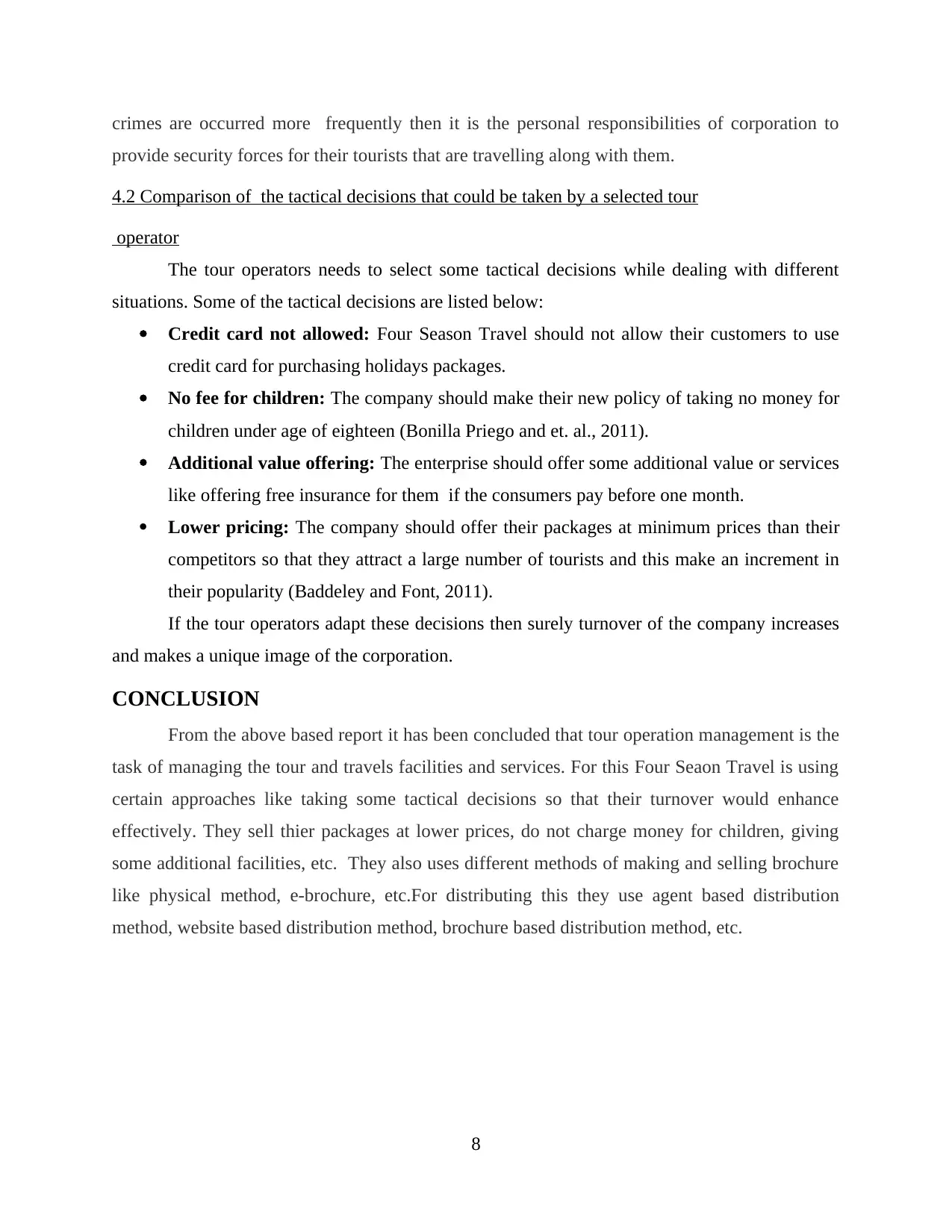
crimes are occurred more frequently then it is the personal responsibilities of corporation to
provide security forces for their tourists that are travelling along with them.
4.2 Comparison of the tactical decisions that could be taken by a selected tour
operator
The tour operators needs to select some tactical decisions while dealing with different
situations. Some of the tactical decisions are listed below:
Credit card not allowed: Four Season Travel should not allow their customers to use
credit card for purchasing holidays packages.
No fee for children: The company should make their new policy of taking no money for
children under age of eighteen (Bonilla Priego and et. al., 2011).
Additional value offering: The enterprise should offer some additional value or services
like offering free insurance for them if the consumers pay before one month.
Lower pricing: The company should offer their packages at minimum prices than their
competitors so that they attract a large number of tourists and this make an increment in
their popularity (Baddeley and Font, 2011).
If the tour operators adapt these decisions then surely turnover of the company increases
and makes a unique image of the corporation.
CONCLUSION
From the above based report it has been concluded that tour operation management is the
task of managing the tour and travels facilities and services. For this Four Seaon Travel is using
certain approaches like taking some tactical decisions so that their turnover would enhance
effectively. They sell thier packages at lower prices, do not charge money for children, giving
some additional facilities, etc. They also uses different methods of making and selling brochure
like physical method, e-brochure, etc.For distributing this they use agent based distribution
method, website based distribution method, brochure based distribution method, etc.
8
provide security forces for their tourists that are travelling along with them.
4.2 Comparison of the tactical decisions that could be taken by a selected tour
operator
The tour operators needs to select some tactical decisions while dealing with different
situations. Some of the tactical decisions are listed below:
Credit card not allowed: Four Season Travel should not allow their customers to use
credit card for purchasing holidays packages.
No fee for children: The company should make their new policy of taking no money for
children under age of eighteen (Bonilla Priego and et. al., 2011).
Additional value offering: The enterprise should offer some additional value or services
like offering free insurance for them if the consumers pay before one month.
Lower pricing: The company should offer their packages at minimum prices than their
competitors so that they attract a large number of tourists and this make an increment in
their popularity (Baddeley and Font, 2011).
If the tour operators adapt these decisions then surely turnover of the company increases
and makes a unique image of the corporation.
CONCLUSION
From the above based report it has been concluded that tour operation management is the
task of managing the tour and travels facilities and services. For this Four Seaon Travel is using
certain approaches like taking some tactical decisions so that their turnover would enhance
effectively. They sell thier packages at lower prices, do not charge money for children, giving
some additional facilities, etc. They also uses different methods of making and selling brochure
like physical method, e-brochure, etc.For distributing this they use agent based distribution
method, website based distribution method, brochure based distribution method, etc.
8
⊘ This is a preview!⊘
Do you want full access?
Subscribe today to unlock all pages.

Trusted by 1+ million students worldwide
1 out of 14
Related Documents
Your All-in-One AI-Powered Toolkit for Academic Success.
+13062052269
info@desklib.com
Available 24*7 on WhatsApp / Email
![[object Object]](/_next/static/media/star-bottom.7253800d.svg)
Unlock your academic potential
Copyright © 2020–2025 A2Z Services. All Rights Reserved. Developed and managed by ZUCOL.





